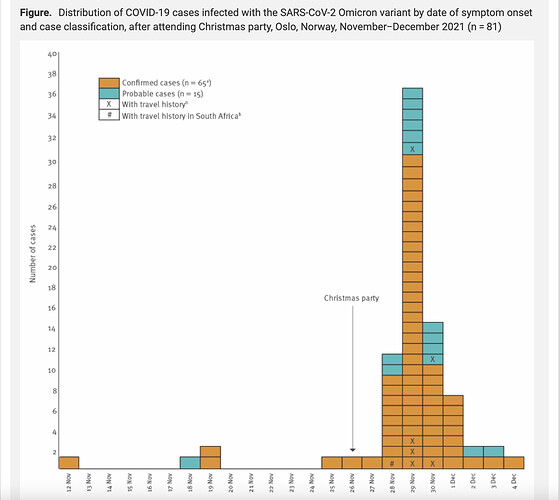Norwegian Institute of Public Health (NIPH) conducted an investigation after it was informed by a local laboratory about the COVID-19 outbreak at a Christmas dinner in Oslo on November 26th. Preliminary results of the investigation were published in the Eurosurveillance Journal on Thursday.
Investigation showed that one of the attendees had returned from South Africa on November 24th. The Omicron variant of the COVID-19 was first identified in Southern Africa in mid-November.
Based on the findings published in Eurosurveillance, of the 111 respondents, 66 (59%) were confirmed cases (26 based on WGS and 40 based on PCR VOC screening) and 15 (14%) were probable cases (PCR-positive only). One PCR-positive attendee was confirmed to be infected with SARS-CoV-2 Delta variant (Pango lineage B.1.617.2), and subsequently excluded from further analysis. The total attack rate for the Omicron variant was 74% (81/110). The cases had an average age of 38 years (SD: 8.6; median 36, range: 26–61) and 35 (43%) were women. The remaining 29 attendees did not have a positive PCR result by 13 December 2021.
Most of the cases (n = 79; 98%) and non-cases (n = 27; 93%) were fully vaccinated with a median time since receiving the last vaccine dose of 79 days for cases and 87 days for non-cases (no statistically significant difference, Wilcoxon rank-sum p = 0.48). Among cases who had received two vaccine doses, 55% (41/75) received Comirnaty (BNT162b2 mRNA, BioNTech-Pfizer, Mainz, Germany/New York, United States (US)) whereas 23% (17/75) received Spikewax (mRNA-1273, Moderna, Cambridge, US). Among the 25 non-cases who had received two doses, seven received Comirnaty whereas 12 received Spikewax.
In addition, during the investigation and as at 13 December, we detected nearly 70 other guests that were likely infected at the venue, and the Omicron variant was detected in 53 of these through PCR variant screening or sequencing.
Here is the summary of findings posted in NIPH website:
The findings indicate that the omicron variant has a high dispersal ability among fully vaccinated adults in social settings with close contact indoors.
Of the 111 participants at the Christmas table who were interviewed, 74% were diagnosed with SARS-CoV-2 afterwards. Of these, 60% confirmed the infection with the omicron variant (as of 13 December 2021). In addition, one participant is infected with the delta variant. Analysis of the samples is still ongoing.
Most cases reported mild symptoms and none have been hospitalized so far.
Over 70% of cases reported the following symptoms: Cough, runny / stuffy nose, lethargy and sore throat. In addition, 50% of cases reported fever.
Some of the cases had been traveling abroad in advance, but none of these had reported symptoms in the period before the Christmas table.
98% of the cases were fully vaccinated. Among those who had received two doses of vaccine, 41/75 had received Comirnaty (BioNTech-Pfizer) and 17/75 had received Spikevax (Moderna). Corresponding figures among the non-infected group were 7/25 Comirnaty (BioNTech-Pfizer) and 12/25 Spikevax (Moderna).
Although we observed some differences in the type of vaccines that dominated among the infected and non-infected, the data base is too thin to conclude whether some vaccine types protect better than others against infection with the omicron variant.
NIPH concluded based on the preliminary investigation that the omicron variant is more contagious and that coronary vaccination is less effective against transmission of infection with omicron than has been seen for the delta variant. At the same time, there are no signs of serious infection among the cases in the outbreak.
Government of Norway Indicted for Crimes Against Humanity Over ‘Planned False Pandemic’
Norway reclassifies Covid-19: No more dangerous than ordinary flu
